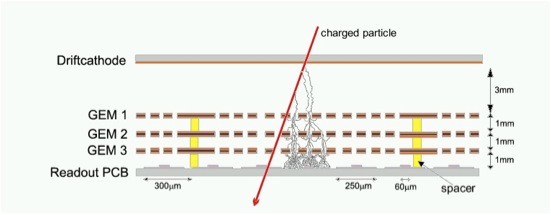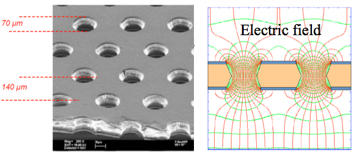H Proposal Defense
Topic
The performance of a neutron sensitive gaseous detector based on thick gaseous electron multiplier detectors.(THGEM)
Introduction
Gaseous detectors using Gas Electron Multipliers [Suili refer] are becoming common in nuclear and high energy physics experiments. The Gas Electron Multipliers act as a preamplifier inside the detector allowing the detector's charge collection elements to decrease in size. The detector has has ability to detect the rare events in a high resolution.In addition to its flexibility to adapt any shape and any detection area needed for any experiment. Furthermore, THGEM is rebust,economic in design and operating.
Neutrons are nucleons with neutral charge, They interacts generally with high atomic number elements that have high cross sections for certain reactions.Mostly,the neutron interactions are represented by fission, capture,conversion (to an alpha or a proton) and scattering.
A neutron THGEM detector project is basically building the detector using the standards related to THGEM detectors, but adding to the detecting surface an element with a high cross section for a neutron interaction. In our case the THGEM foil will be covered by thorium-232 or uranium-238 which have relatively a high cross section for fission when the neutron energy range is between 5-14 MeV.
The THGEM neutron detector is supported by a read out wire net to get the signal, the read out wire net is connected to a gum stick and a break board, a software (coda) is responsible for collecting and filing the data, then analyzing the data by ROOT (software package).
Chapter 1
Electron Multiplication
The electrons are fermions, negatively charged particles, located around the nucleus. Electron ionization is releasing the electron(s) of the gas from the domain of the nucleus. Any element has an ionization energy, the electron becomes free when it gets an energy higher than its ionization energy.
Lets have positively charged particle like a fission fragment with a certain kinetic energy in an argon gas, electron will starts scattering around the path in all direction for many reasons, but the starting point is bremsstrahlung radiation produced by the decelerating fission fragment,or by colliding directly with the gas atom. the primary electrons produced may also interact with the gas electrons and release more electrons through electron-electron interactions.
In the case of low interacting particles with the gas, the number of the electrons released will not be enough to give an indication of the existence of this particle, so any electron produced primarily should be multiplied.
The free electrons are collected by the surrounding electric field toward a foil with holes, as the electron passes through one of the holes it will be multiplied. (ref.1)
Microscopically, as the electron passes through the hole that has a high concentration of electric field lines, the confinement of the space with strong electric filed will increase the probability of gas ionization to end up with a large number of electrons coming out from the other side of the foil. This process is known by Gas Avalanche multiplication. (ref.1)
Thick Gaseous Electron Multiplier (THGEM) Design
THGEM detector consists of a gas chamber,THGEM foils,read out wire net, high voltage circuit. A THGEM foil is made from FR4 G10 double sided copper clad, FR4 is 12x12 square plate of thickness is 1 mm and Copper 17 um. Each foil chemically is etched to leave a corner cut square shape frame of length 10cm as represented in the figure. The foil then is painted with a thin layer of a resistive paste (ED-7100) enough to have the current flow on the surface.The foil is machined to have a hole of diameter 0.5 with a rim of 0.15mm from both sides and pitch of 0.8 mm.
GEM and THGEM
The first generation of the electron multipliers was the GEM (gas electron multiplier), characterized by micrometer scale hole diameter and pitch, also operated as the GEM foil voltage within 350 V, flexibility in taking any shape, high gain at low voltage. Nevertheless, GEM foil sparking rate increases rapidly,micrometer scale for the design make it hard to maintain. When the design of GEM detector becomes in millimeter scale, the characteristics will change, the new design is called THGEM (thick gaseous electron multiplier).
With the new design for THGEM, the foil becomes rebust, has a higher operating voltage and relatively a higher gain.

